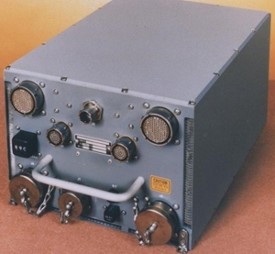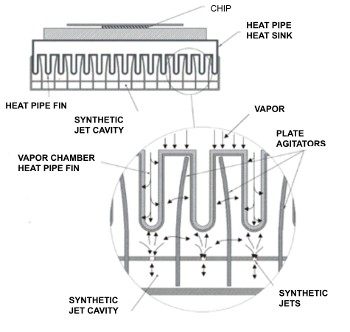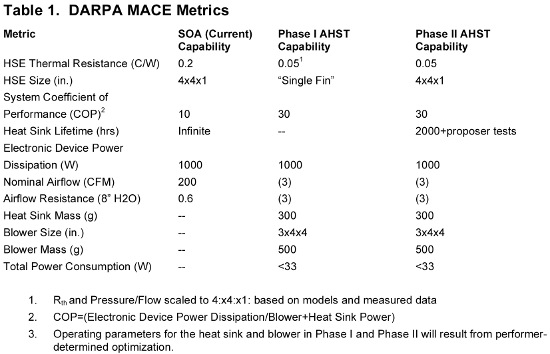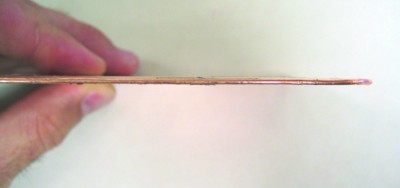 |
| May 08, 2012 | Volume 08 Issue 18 |
Designfax weekly eMagazine
Archives
Partners
Manufacturing Center
Product Spotlight
Modern Applications News
Metalworking Ideas For
Today's Job Shops
Tooling and Production
Strategies for large
metalworking plants
Active heat sink cools high-power electronic devices
Maintaining the viability of air-cooled thermal management through a variety of micro-technologies
By Nelson Gernert, Vice President of Engineering and Technology, Thermacore, Inc.

Air-cooled attenuated total reflection (ATR) device, suitable for Active Heat Sink Technology (AHST) technology.
The issue of thermal management in military, and ultimately, commercial electronic systems has become increasingly important due to more powerful electronic processing capabilities and the resulting heat generation, along with a lower heat tolerance in next-generation electronic components. In addition, military and aerospace electronic components are being tasked to maintain higher performance under more demanding climatic conditions.
As commercial technology migrates to high-density storage and computing solutions, the problems of thermal management increase. Typically, the allocation for space, power, and heat transfer is not expanded when these new technologies are implemented. Therefore, thermal management can become a potentially limiting design factor unless heat transfer is addressed upfront.
With this in mind, it has been suggested that the effectiveness of air as a heat sink cooling medium is reaching its practical limits in today's military applications, largely due to air-side heat transfer directly at electronic components. Additional challenges currently facing designers of state-of-the-art (SOA) heat sink assemblies include the lack of air penetration into areas where high surface area treatments are applied to heat sink surfaces, the low thermal conductivity of polymers used in heat sinks, and the development of a thermal barrier on SOA heat sink surfaces at high temperatures.
The alternative to air cooling, of course, is pumped liquid or refrigerant-based cooling systems, with their added complexity, weight, and potential for failure (particularly in the context of six-sigma mission failure rate requirements). The use of air cooling in heat sinks is also more environmentally friendly and carries less risk of chemical contamination or interactions. Finally, the added complexity of pumps, compressors, nozzles, and other liquid cooling components can mean significant additional cost.
The Defense Advanced Research Projects Agency (DARPA) has recently launched an initiative designed to maintain the viability of air-cooled thermal management solutions and postpone a transition to pumped liquid or refrigeration cooling. This initiative, the Micro-technologies for Air-Cooled Exchangers (MACE) program, is intended to significantly improve the thermal performance of military electronic systems, including telecommunications, active sensing, and imaging, radar, and other platforms. The goal of the MACE program is to develop micro-technologies that leverage existing strengths of air-cooled heat sinks while improving thermal performance and reducing electrical consumption. This will enable designers to avoid the need for incorporating pumped liquid cooling, spray cooling, submersion cooling, vapor-compression refrigeration cooling, and other similar systems in order to achieve optimal thermal management.
Some of the interesting work in heat sink design for the MACE program is being done by a team of academic and commercial scientific partners led by Thermacore, Inc., a Lancaster, PA-based thermal solution specialist. Thermacore is currently working in conjunction with the University of Minnesota, Lockheed Martin Company, and the Bergquist Torrington Company to explore leading-edge Active Heat Sink Technology (AHST) that will meet DARPA requirements for MACE.
Developments in Active Heat Sink Technology
One AHST approach to enhancing current air-cooled heat sink technology involves a blend of existing thermal heat sink solutions, with targeted enhancements to improve the efficiency of air movement. The AHST designers are proposing a modular micro-cooling system combining heat pipe technology, polymer circuit-bearing plate agitators, synthetic jets agitators, and an energy-efficient centrifugal air mover or blower.

A baseline approach to Active Heat Sink Technology (AHST) showing heat pipe, plate agitator, and synthetic jet components.
The passive heat sink design is comprised of thin (2-mm) vapor chamber heat pipe technology that keeps the entire heat sink surface, including its fins, nearly isothermal. Thin copper heat sink pipe plates serve as fins and are integrated with the heat pipe base being developed by Thermacore. The advantage of this solution is that heat pipe technology can transport heat – which will come from a single or several discrete electronic elements – equally to all heat sink surfaces. This is important in light of the fact that MACE requirements suggest using the entire heat sink assembly base for heat input. In real-world applications, the limited number of heat input sources means heat spreading will likely become an issue. Thin vapor chamber heat pipe technology will allow vapor heat transport from the base to the fin tips.
To improve heat transfer coefficients at the base and over the fin sides, the AHST enhanced heat sink design concept will rely on piezoelectric-driven polymer plate agitator (PEAT) technology. PEAT plate agitators are bonded to a polymeric substrate or built on the surface of a silicon substrate to support high-aspect-ratio, thin polymeric microstructures, which serve as agitator flaps. Piezoelectric components, composed of two interlocked structures, are controlled by electric impulses that cause the polymeric plates to vibrate rapidly back and forth between two of the thin metal fins. The rapid movement of the polymeric plates, not unlike the buzzing of an insect's wing, causes surface pressure fluctuations inside the spaces enclosed by the heat pipe fins. These fluctuations are the key to defeating the thermal boundary layer, because they rapidly agitate air to create high-velocity air jets with resulting turbulence, which in turn disrupts and thins the thermal boundary layer. The result is enhanced heat transfer coefficients on the heat sink surfaces. Initial calculations indicate that this actuation can be accomplished using less than 33 W of electricity, the DARPA MACE standard.
Heat transfer around fin tips, and on the fin surfaces near the tips, is further enhanced by synthetic jet (SYNJ) agitators, an existing technology that the ASHT concept applies in new ways. Piezoelectric components, built into or bonded to silicon or polymer membranes, cause rapid vibration, as on the surface of a drum. The agitators are constructed using silicon bulk micromachining or polymer hot embossing to create cavities and piezoelectric-rich membranes. A hole in the surface of each SYNJ agitator serves as a jet orifice, emitting air. The combined action of numerous agitators (the ASHT design can support up to several hundred) causes the emitted air to impinge on heat sink surfaces, thinning the thermal boundary layer near stagnation point during a portion of the actuator cycle. During the remainder of the cycle, the SYNJ agitators also disrupt the boundary layer with elevated near-wall turbulence. Being constructed of a polymer with low stiffness, the SYNJ agitators are very flexible and durable, providing continuous convective (rather than conductive) heat transfer enhancement. In this way the lower thermal conductivity of the polymer is not an issue. Preliminary, and conservative, analysis suggests that AHST thermal resistance of 0.04 kW is attainable, which is superior to the DARPA-specified performance goal of 0.05 kW.
The final element in the AHST thermal management concept is an energy-efficient centrifugal blower to create bulk air movement through the heat sink. Calculations that take into account available fin thickness and DARPA-mandated maximum fan scroll size indicate that DARPA blower performance, size, and power metrics (<33 W) can be met. This is accomplished primarily through key improvements in blower, motor, and drive electronics. All in all, the AHST thermal management system appears on track to meet all of the MACE metrics for energy-efficient performance (see table).

While a complete solution is likely still several years away, a proof-of-concept evaluation involving several AHST elements (including one demonstration fin) will soon take place. The demonstration fin will feature one of the technology alternatives that are being explored as an adjunct to baseline AHST technology: carbon nanotubes/nanomodules attached to the heat pipe heat sink surface. The nanoscale features can act as fins to enhance the thermal contact area with air flow, thanks to high-thermal-conductivity materials. AHST developers are also experimenting with an alternate method of agitating plate actuators using electrostatic controls (high-aspect-ratio polymeric agitators with two suspended beams on a polymeric substrate).

Thermacore's thin heat pipe used in AHST development.
Potential applications
Typical military and aerospace systems that represent potential applications for AHST thermal management solutions include the Theater High Altitude Area Defense (THAAD) missile system, on-board warship electronics (e.g., for the Navy DDG 1000/Zumwalt destroyer), and fighter plane avionics and weapons system controls (e.g., for the F-16 and the Joint Strike Fighter). Commercial thermal management applications involving hand-held communications devices, scanners, and laptops are certain to develop at a later time. The AHST concept promises to be very versatile and applicable to a wide range of system environments (although it may not be ideal for tall, vertical heat sinks, where actuator fatigue may be an issue). It should be noted that the extensive acceptance of heat pipes by the military means that the proposed heat pipe technology in this MACE solution is likely to be implemented, if AHST performs as expected and environmental test criteria are addressed.
The heart of the AHST thermal management strategy developed by Thermacore and partners lies in concepts that are familiar and, conceptually, proven in real-life applications. These concepts have been blended in a novel way that promises to extend the capabilities of air-cooled heat sinks and delay by several years the necessity to switch to more complex liquid-based thermal management systems.
MACE environmental criteria
- Altitude: 30,000 ft objective, 80,000 ft threshold.
- Fungus: Fungus inert.
- Humidity, fluid, and atmospheric corrosives: Resistant to these types of environments.
- Explosive atmospheres: No ignition in explosive atmospheres associated with aircraft, automotive, and marine fuels.
- Humidity/moisture (resistance to neutral and acidified salt fog): 350 hr objective, 500 hr threshold.
- Sand, dust, lint, and hair in forward and reverse directions: Non-susceptible.
- Vibration resistance: Random, 10 hr, W0=0, 1G/2Hz. Sinusoidal: 10G at 60 Hz, 120 Hz, 180 Hz and 220 Hz for 15 min.
- Shock (G load resistance for 11 ms): 20G operational, 20G safety.
- System reliability (life): 150,000 hr (30 yr).
NOTE: The views, opinions, and/or findings contained in this article/presentation are those of the author/presenter and should not be interpreted as representing the official views or policies, either expressed or implied, of the Defense Advanced Research Projects Agency or the Department of Defense. (Approved for Public Release, Distribution Unlimited)
Want more information? Click below.
Thermacore
Rate this article
View our terms of use and privacy policy
